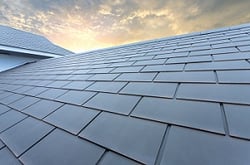
The roof of your home takes a lot of abuse, especially in hot climates where the sun beats down day after day with punishing heat. A poorly made roof will break down and degrade over the years. It can also allow the heat to transfer into the house more easily - causing cooling bills to be higher than necessary.
The ideal type of roof for this climate would not only stand up well under the elements, but also deflect some of the heat and potentially contribute to keeping your home cooler.
Here are the top roofing materials for hot climates:
Terra-Cotta Tiles
Terra-cotta is a very popular roofing material in the Southwest and it’s not just because of the Spanish style it gives your home. The tiles are made from baked clay that stand up very well over time due to their weather-resistant properties. The curved shape also contributes to their energy efficient performance. The space below allows air to circulate and keep everything cooler.
Unfortunately, there are some negatives to this material. The weight can be an issue because terra-cotta tiles weigh two to four times as much as conventional roofing materials. This can be a problem if the home needs to be reinforced to be able to handle that load. These tiles are also one of the most expensive materials for roofing, however considering their long lifespan they can still be a good investment.
Concrete
Concrete tiles are a good alternative if you want to have something that works in a similar way to terra-cotta but costs less. Concrete is very thick and takes longer for the heat to reach inside the house.
Slab concrete is the cheaper version of this material, however it’s very heavy and is not as aesthetically pleasing. Roofing manufacturers also make concrete tiles that have the same wave shape as terra-cotta, giving them similar airflow properties and have added color to them to create a more polished look.
Composite Roofing
EPDM is sometimes called rubber roofing, but it isn’t rubber at all. It’s a synthetic material called ethylene propylene diene monomer or EPDM. This material holds up very well in extreme conditions and is effective at heat reduction when it has a titanium dioxide coating. However, there are some potential concerns from an environmental standpoint, as a study on the long-term effects of this kind of “cool roof” showed a decrease in local rainfall, something that is worth taking into consideration.
Metal Roofing
Metal roofs have been in and out of style over the years. In the recent past they were seen as cheap and mostly used for rural barns. But in past 10-15 years, metal roofing has come back into style. Part of the reason for this trend is the sustainability of the material, as metal roofs are often made from recycled materials and are also highly recyclable at the end of their useful life.
Their environmental reputation certainly helps in the appeal, but there is also the benefit of energy efficiency. In hot climates, the cost of cooling your home can be extremely high - so the fact that a metal roofing system features an important airspace between the panels and the decking makes it a compelling material choice. This airspace acts as a barrier and doesn’t allow transfer to the interior spaces beneath. It’s possible for energy cost savings to be as great as 20%.
Which roof is right for you?
Exterior material choice is critical to the life of a structure, especially when it comes to roofing. Selecting the ideal material for your climate can make the difference between a new roof in ten years or a new roof in thirty. Hot climates create a unique strain on your roof structure, so be thoughtful about the choice you make when installing a new roof. Also use fasteners and tools designed for the task at hand, like the Slate Roof System from the BECK, created to help install slate roof tiles in less time, while maintaining universal depth and spacing or the SCRAIL® RoofLoc® Metal Roofing system from BECK, designed to make metal roof installs a snap. With the right material and quality installation, your roof will stand up to the heat and last a lifetime.
.svg.png)

